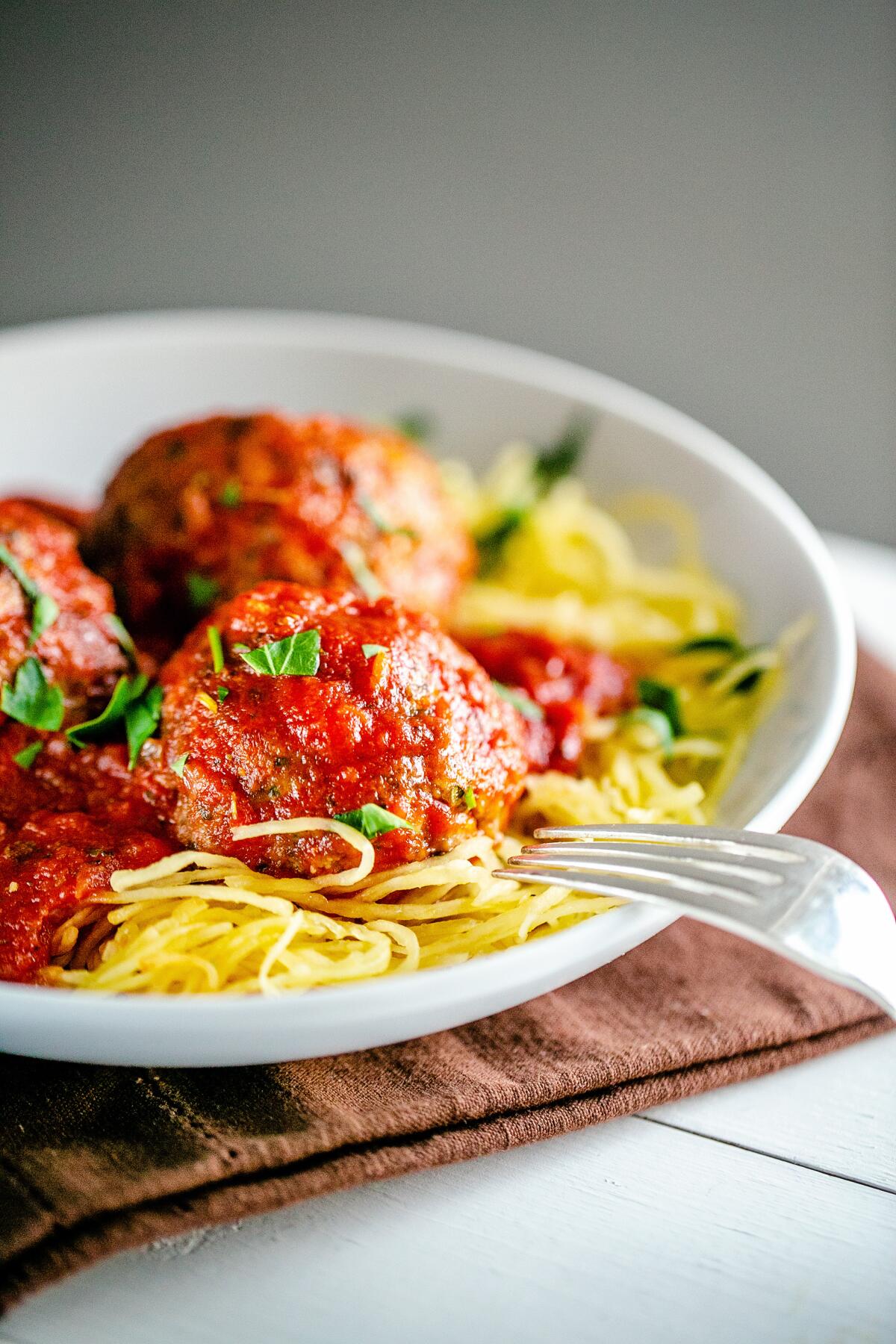For fork-tender meatballs, handle with care

Getting meaty bites with the ideal juicy texture and flavor boils down to two things: good technique and the right ingredients
My father’s meatballs have always been famous among our family and friends. Whether served in sandwiches, accompanied by spaghetti or served with his even more popular lasagna, his meatballs inevitably stole the show.
You’d think that making meatballs would be an easy endeavor. Made with ground meat, seasoning, egg, milk, sometimes a little bread or oats … how hard can it be?
My experience has proved that the perfect meatball is somewhat elusive even when eating out. For me, ordering meatballs at restaurants can be hit or miss, sometimes both at the same restaurant. They can lack flavor and be overcooked and tough or mushy and spongy.
Dad’s tender, flavorful meatballs have spoiled me.
So I decided to share a few family secrets to making a good meatball at home. Is this the quintessential Italian meatball? Hardly. After all, we are not Italian, but neither are we strangers to meatball-making, with albondigas (meatball) soup being a popular Mexican soup. Plus, Dad did work in professional restaurant kitchens for a bit and incorporated some of the techniques he learned into his method for making tender meatballs. I’ve taken those techniques that I learned from Dad and combined them with a variety of some of my favorite flavor profiles to create consistently tender meatballs.
No. 1 on the list, and it holds whether you’re making meatballs, meatloaf or hamburger patties: Don’t overwork the meat. Doing so compacts it, making it dense and, ultimately, tough. I use a carving fork for meatballs and meatloaf to combine ingredients (chopsticks work well, or simply an open hand with fingers flared). I use quick short “rakes” through the mixture, folding in the ingredients and lifting the meat up and over, tapping the carving fork frequently against the bowl to release meat stuck on the tines.
Second, use two types of meat: Although many meatball recipes use just ground beef, I prefer to add some ground pork. In addition to adding juiciness, I find the pork adds more flavor. This is especially helpful if using turkey or chicken in place of beef, as they can be pretty lean (fat equals flavor).
Next tip? Use fresh herbs whenever possible — lots of them. I use fresh parsley, oregano and marjoram. Equally important: Add onion and fresh garlic. The trick here, though, is to grate the onion instead of chopping, and run the garlic through a garlic press. Grating the onions and pressing the garlic means you aren’t biting into chunks of either, yet both vegetables delicately flavor each bite.
And lastly, this next suggestion is borrowed from the baking world: Combine all the wet ingredients and seasonings before adding them to the meat to cut down on the amount of handling the meat needs to endure.
As for browning the meatballs before baking them, I’m going to leave that up to you. Honestly, I often don’t feel like taking the time to brown them first and just pop them straight into a hot oven instead.
When I was developing this dish, I was on a low-carb, no-white-flour diet but was craving spaghetti and meatballs. I was determined to enjoy my craving without crashing my diet. Here, I have spaghetti squash stepping in for pasta. I have come to like this “spaghetti” quite a bit, maybe even more than wheat spaghetti, because I can enjoy my meal without enduring a carb coma 20 minutes after eating.
Give it a try this way, and let me know what you think.
And if you prefer traditional pasta, go for it — no judgment here.
Spaghetti (Squash) and Meatballs With Quick Tomato Sauce
This recipe makes about 20 meatballs using a size 16 foodservice scoop (bowl holds 2.75 ounces, bought locally at Smart & Final, green handle). The squash and the sauce serve 6 with two meatballs each. Freeze the rest of the meatballs for later use. I love to pull them out of the freezer, pop them into a steamer basket (or, if really in a hurry, the microwave) for quick last-minute meals. Double the sauce and squash, and you can easily serve 10.
Makes 6 servings (2 meatballs each, with leftover meatballs to freeze)
1 spaghetti squash, approximately 5 pounds
¼ cup water
1½ pounds extra-lean ground beef
1 pound extra-lean ground pork
3 cups cubed whole wheat bread (about 3 slices)
¾ cup milk (whole or low-fat)
1 cup loosely packed fresh flat-leaf parsley, thick stems removed
¼ cup finely chopped fresh oregano
1 tablespoon finely chopped fresh marjoram (or 1 teaspoon dried)
1 small white onion, cold (see Cook’s note)
2 cloves garlic, run through a garlic press
1 large egg, lightly beaten
⅔ cups grated parmesan
2 teaspoons sea salt
½ teaspoon ground black pepper
FOR THE SAUCE:
2 tablespoons extra-virgin olive oil
¼ medium onion, minced (about ⅓ cup)
½ rib celery, minced (about ⅓ cup)
1 fat clove garlic, minced
1 (15-ounce) can crushed tomatoes
1 (8-ounce) can tomato sauce
1 tablespoon Italian tomato paste
½ teaspoon sea salt, or to taste
Dash of black pepper, or to taste
Pinch of red pepper flakes
1 sprig fresh oregano
1 sprig fresh basil
GARNISHES:
Grated Parmesan cheese
Freshly chopped parsley or basil
Preheat oven to 425 degrees.
Bake the squash: Split the squash in half lengthwise. Remove and discard seeds. Place cut-side down onto a rimmed baking sheet (see Cook’s note). Add ¼ cup water and roast for 25-30 minutes or until “al dente” (the squash flesh should easily pull apart into spaghettilike strands when raked with a fork but still have a bit of crunch; don’t overbake, as it will get mushy). When ready, remove from oven, cover with foil and set aside. Lower oven temperature to 400 degrees.
Make the meatballs: Place the two types of meat into a large bowl and use a carving fork or your fingers to break them apart and combine. Be careful not to compact or overwork; set aside.
Place the cubed bread in a large bowl and pour in the milk. Stir well and let stand 10 minutes.
In the meantime, chop the fresh parsley, oregano and marjoram. Using a food processor or the large holes on a box grater, grate the onion. Using a garlic press, push the clove through to mince. Crack the egg into a small cup and lightly beat, breaking up the yolk.
Back to the bread mixture: Give it a good stir, then use your hands to crush any chunks and bits of crusts until the texture resembles oatmeal. Stir in the chopped herbs, grated onion, pressed garlic, egg, Parmesan, salt and pepper. Pour into the meat mixture — alternate raking and folding the meat to combine the ingredients.
Spray a rimmed baking sheet with olive oil cooking spray. Use a scoop to portion out the meatballs onto wet hands. Carefully roll into a ball shape, handling the meatball as little as possible, then place onto the prepared baking pan. Bake meatballs for 20 minutes in a 400-degree oven. Remove the meatballs when the internal temperature registers 160 degrees on an instant-read thermometer. When finished cooking, remove from oven, tent with foil, and rest 10 minutes (internal temperature will continue to rise to about 165 degrees).
Make the sauce: Drizzle the olive oil into a large skillet. When shimmering, add onion and celery; cook for 2 minutes, stirring occasionally. Add garlic and continue to stir and cook 1 minute more. Add crushed tomatoes, tomato sauce, tomato paste and stir well to combine. Sprinkle in the salt, pepper and red pepper flakes; stir, taste and adjust seasoning. Add the sprigs of oregano and basil and bring sauce to a boil, reduce heat to medium-low and simmer for 15 minutes. Turn off the heat and remove herb sprigs.
To serve: Rake the squash with a fork to create “noodles” and divide between 6 pasta bowls. Add 12 meatballs to the sauce, turn to coat, then scoop out two meatballs into each bowl. Divide the sauce among the bowls. Garnish with additional Parmesan cheese and fresh chopped parsley or basil.
Cook’s notes: Cold onions release less of the tear-inducing enzyme when cutting them. Place the onion in the freezer for 10-15 minutes before you need it.
For baking both the squash and the meatballs, I used a pair of rimmed ¼ sheet pans (aka jelly roll pans). If you want your meatballs a little more crispy on the exterior, use a larger rimmed baking sheet and space meatballs 1 to 1 ½ inches apart. I like to pack mine somewhat tightly, so they stay juicier.
Recipe is copyrighted by Anita L. Arambula and is reprinted by permission from Confessions of a Foodie.
Arambula is the food section art director and designer. She blogs at confessionsofafoodie.me, where the original version of this article was published. Follow her on Instagram: @afotogirl. She can be reached at anita.arambula@sduniontribune.com.






